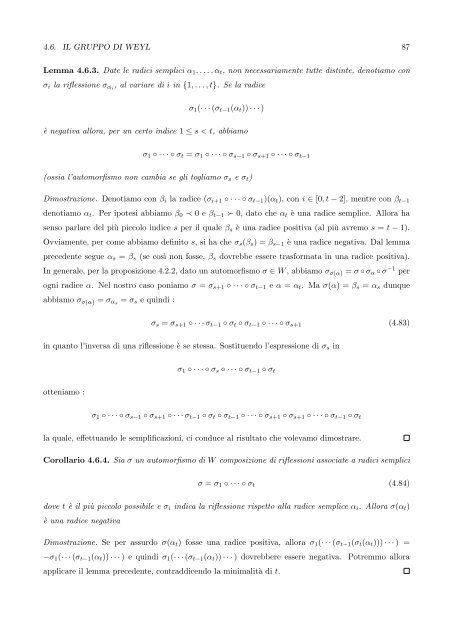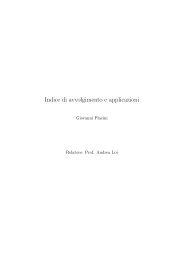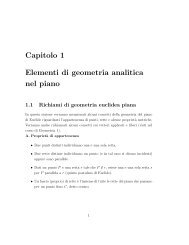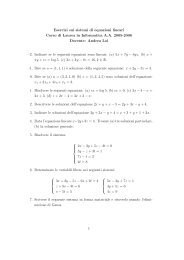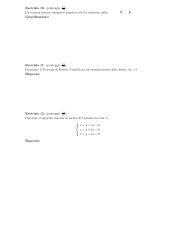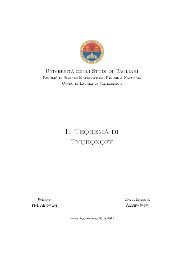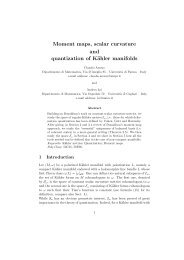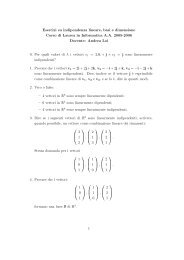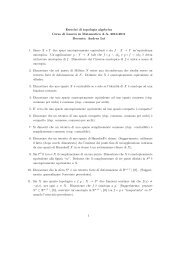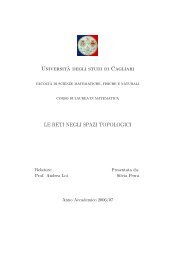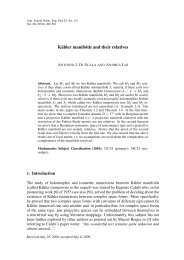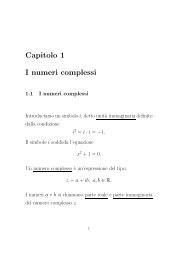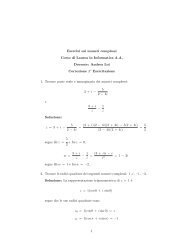Algebre di Lie semisemplici, sistemi di radici e loro classificazione
Algebre di Lie semisemplici, sistemi di radici e loro classificazione
Algebre di Lie semisemplici, sistemi di radici e loro classificazione
Create successful ePaper yourself
Turn your PDF publications into a flip-book with our unique Google optimized e-Paper software.
4.6. IL GRUPPO DI WEYL 87<br />
Lemma 4.6.3. Date le ra<strong>di</strong>ci semplici α1, . . . , αt, non necessariamente tutte <strong>di</strong>stinte, denotiamo con<br />
σi la riflessione σαi , al variare <strong>di</strong> i in {1, . . . , t}. Se la ra<strong>di</strong>ce<br />
σ1(· · · (σt−1(αt)) · · · )<br />
è negativa allora, per un certo in<strong>di</strong>ce 1 ≤ s < t, abbiamo<br />
σ1 ◦ · · · ◦ σt = σ1 ◦ · · · ◦ σs−1 ◦ σs+1 ◦ · · · ◦ σt−1<br />
(ossia l’automorfismo non cambia se gli togliamo σs e σt)<br />
Dimostrazione. Denotiamo con βi la ra<strong>di</strong>ce (σi+1 ◦ · · · ◦ σt−1)(αt), con i ∈ [0, t − 2], mentre con βt−1<br />
denotiamo αt. Per ipotesi abbiamo β0 ≺ 0 e βt−1 ≻ 0, dato che αt è una ra<strong>di</strong>ce semplice. Allora ha<br />
senso parlare del più piccolo in<strong>di</strong>ce s per il quale βs è una ra<strong>di</strong>ce positiva (al più avremo s = t − 1).<br />
Ovviamente, per come abbiamo definito s, si ha che σs(βs) = βs−1 è una ra<strong>di</strong>ce negativa. Dal lemma<br />
precedente segue αs = βs (se così non fosse, βs dovrebbe essere trasformata in una ra<strong>di</strong>ce positiva).<br />
In generale, per la proposizione 4.2.2, dato un automorfismo σ ∈ W , abbiamo σ σ(α) = σ ◦ σα ◦ σ −1 per<br />
ogni ra<strong>di</strong>ce α. Nel nostro caso poniamo σ = σs+1 ◦ · · · ◦ σt−1 e α = αt. Ma σ(α) = βs = αs dunque<br />
abbiamo σ σ(α) = σαs = σs e quin<strong>di</strong> :<br />
σs = σs+1 ◦ · · · σt−1 ◦ σt ◦ σt−1 ◦ · · · ◦ σs+1<br />
in quanto l’inversa <strong>di</strong> una riflessione è se stessa. Sostituendo l’espressione <strong>di</strong> σs in<br />
otteniamo :<br />
σ1 ◦ · · · ◦ σs ◦ · · · ◦ σt−1 ◦ σt<br />
σ1 ◦ · · · ◦ σs−1 ◦ σs+1 ◦ · · · σt−1 ◦ σt ◦ σt−1 ◦ · · · ◦ σs+1 ◦ σs+1 ◦ · · · ◦ σt−1 ◦ σt<br />
la quale, effettuando le semplificazioni, ci conduce al risultato che volevamo <strong>di</strong>mostrare.<br />
(4.83)<br />
Corollario 4.6.4. Sia σ un automorfismo <strong>di</strong> W composizione <strong>di</strong> riflessioni associate a ra<strong>di</strong>ci semplici<br />
σ = σ1 ◦ · · · ◦ σt<br />
(4.84)<br />
dove t è il più piccolo possibile e σi in<strong>di</strong>ca la riflessione rispetto alla ra<strong>di</strong>ce semplice αi. Allora σ(αt)<br />
è una ra<strong>di</strong>ce negativa<br />
Dimostrazione. Se per assurdo σ(αt) fosse una ra<strong>di</strong>ce positiva, allora σ1(· · · (σt−1(σt(αt))) · · · ) =<br />
−σ1(· · · (σt−1(αt)) · · · ) e quin<strong>di</strong> σ1(· · · (σt−1(αt)) · · · ) dovrebbere essere negativa. Potremmo allora<br />
applicare il lemma precedente, contrad<strong>di</strong>cendo la minimalità <strong>di</strong> t.


